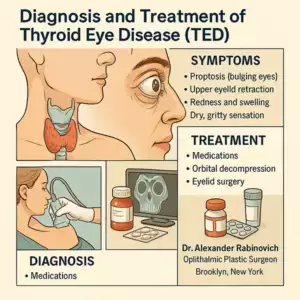By Dr. Alexander Rabinovich, Ophthalmic Plastic Surgeon in Brooklyn, New York
Thyroid Eye Disease (TED), also known as thyroid-associated ophthalmopathy or Graves’ orbitopathy, is a complex autoimmune condition that affects the muscles and soft tissues around the eyes. It is most commonly linked to Graves’ disease—an autoimmune disorder that targets the thyroid gland and may also impact the eyes, skin, heart, and nervous system. Due to its multifaceted nature, the treatment of thyroid eye disease often requires a tailored approach based on both thyroid function and eye involvement.
TED develops in roughly 25–50% of individuals with Graves’ disease. While it can affect anyone, it occurs more frequently in women, particularly between the ages of 30 and 50. Smoking, including exposure to secondhand smoke, is one of the strongest known risk factors for the progression and severity of TED, and it can significantly complicate the treatment of thyroid eye disease.

What Are the Symptoms of Thyroid Eye Disease?
TED symptoms can range from mild irritation to severe vision problems. Common signs include:
- Proptosis (bulging eyes) – one or both eyes may appear to protrude
- Upper eyelid retraction – one eye may appear more “open” than the other
- Dry, gritty, or irritated eyes
- Swelling or puffiness around the eyes
- Double vision (diplopia) – due to involvement of extraocular muscles
- Pressure or pain behind the eyes
- Difficulty closing the eyes fully
- Blurry vision or vision loss – in severe cases involving optic nerve compression
Early diagnosis is essential. While thyroid hormone tests help assess thyroid function, a clinical eye examination is often the first step to confirming TED. Imaging studies like CT or MRI scans may also be used to assess inflammation or compression around the eyes.
Why Prompt Treatment Matters
Although some mild forms of Thyroid Eye Disease may stabilize or improve over time, moderate to severe cases can progress, resulting in permanent vision problems, facial disfigurement, or chronic eye discomfort if left untreated. This is why timely and expert treatment of thyroid eye disease is essential to prevent long-term complications and restore quality of life.
Treatment Options at a Glance
⭐ Mild Cases:
- Lubricating eye drops to relieve dryness and irritation
- Cold compresses and selenium supplements (if recommended)
- Smoking cessation – a critical factor in slowing or reversing progression
⭐ Moderate to Severe Cases:
- Oral or intravenous corticosteroids – reduce inflammation
- Orbital decompression surgery – creates space for swollen tissues by removing bone from behind the eye
- Prism glasses – used to correct double vision
- Strabismus (eye muscle) surgery – after disease stabilization (usually 6+ months)
- Eyelid surgery – addresses retracted eyelids or exposure-related issues
- Nighttime lubricating gels – to help with eye closure difficulty
Each treatment is tailored based on disease severity, progression, and the patient’s overall health.
How Dr. Alexander Rabinovich Can Help
If you’re experiencing any symptoms of Thyroid Eye Disease, Dr. Alexander Rabinovich, an experienced ophthalmic plastic surgeon based in Brooklyn, New York, is here to guide you through diagnosis and treatment. His approach is personal, professional, and rooted in the most effective and up-to-date surgical and non-surgical techniques.
Dr. Rabinovich specializes in:
- Precise orbital decompression for proptosis relief
- Custom eyelid surgeries that restore both comfort and appearance
- Visual function preservation through early detection and intervention
- Minimally invasive solutions, whenever possible
His calm, confident care has helped many patients not only manage TED but return to a normal life, free from pain and fear.
Realistic Outcomes and Hopeful Results
TED can be overwhelming—but it is manageable. Whether your symptoms are mild or vision-threatening, you are not alone. With Dr. Rabinovich, you’ll get an accurate diagnosis, a clear explanation of your options, and a treatment plan designed specifically for you.
“You will be cared for with compassion, precision, and the confidence that things can get better.”
Ready to Take the Next Step?
Dr. Alexander Rabinovich welcomes new patients for consultations in his Brooklyn office. You can schedule an appointment through the chat on the website or via ZocDoc.
Don’t wait for symptoms to worsen. Early attention is the key to preserving your vision, comfort, and confidence.
📍 Dr. Alexander Rabinovich, MD
Ophthalmic Plastic Surgeon
Brooklyn, New York
ZocDoc Profile
Chat available here on this official website

